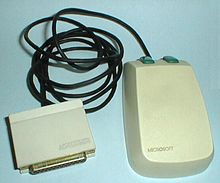 | |
| Manufacturer | Microsoft Alps Electric (contract manufacturer) |
|---|---|
| Type | Mouse |
| Release date | 2 May 1983 |
The Microsoft Mouse is a computer mouse released by Microsoft in 1983. It is the first mouse released by the company, and it was bundled with the first versions of Microsoft Word, and/or Notepad (inclusion of these two programs varied in the initial product release), an on-screen teaching tutorial, a musical piano program, a game, and one of the first home computer color bitmap creation programs, called “Doodle,” for an initial price of $195.
The Microsoft Mouse featured a pair of green buttons, and was nicknamed the "green-eyed mouse". As with other mice at the time, the Microsoft Mouse used a steel ball for tracking. The Japanese company Alps Electric produced the mouse.
The initial version featured a DB-25 Serial Port. Later versions were available with an InPort ISA interface, requiring a Microsoft bus card to be installed in the computer or a DE-9 serial connector. All versions of the Microsoft Mouse could be used with IBM-compatible and other DOS systems.
Later Microsoft mice
In 1985 Microsoft introduced the "gray-eyed" Microsoft Mouse, featuring a higher resolution than competing mice, and a rebadged copy of ZSoft PC Paintbrush called “PC Paintbrush,” which replaced Doodle in version 4 of the drivers. This would later be re-tooled and included with Windows 1, and formed the basis for Microsoft Paint. In 1987 the "dove bar" Microsoft Mouse (so called for the curved palm rest's resemblance to a Dove soap bar) was introduced, in variants for both Microsoft's InPort, serial port and PS/2 port. In 1991, the trackball "Microsoft BallPoint Mouse" was made. The "kidney" Microsoft Mouse 2.0 was introduced in 1993, and its design served as the basis for the IntelliMouse, which debuted in 1996.
More Microsoft mice have been released in later years, including Microsoft Natural Wireless Laser Mouse, Microsoft SideWinder, Arc Mouse, Microsoft Sculpt Ergonomic Mouse and others.
In January 2024, Microsoft announced that it would license the design and manufacturing of its current mice products to Incase, as part of an effort to focus more on its Surface-branded accessories. These products will be branded under the Incase name, but as being designed by Microsoft.
References
- Markoff, John (1983-05-30). "Mouse and new WP program join Microsoft product lineup". InfoWorld. p. 10. Retrieved 2024-12-29.
- "The good, bad and ugly history of Microsoft hardware". PCWorld. Retrieved 2017-05-04.
- Weber, Harrison (2012-05-28). "30 Years of Microsoft Hardware: From Mice to Men". The Next Web. Retrieved 2017-05-04.
- "Winworld: Microsoft Mouse 1.0". Winworld. 2024-03-03. Retrieved 2024-03-03.
- ^ "Microsoft Green Eyed Mouse ~ o l d m o u s e .c o m ~". www.oldmouse.com. Archived from the original on 2017-05-08. Retrieved 2017-05-05.
- "What did Microsoft's first computer mouse look like? It was created exactly 40 years ago (photos)". NEWS.am TECH - Innovations and science. 2023-05-12. Retrieved 2024-03-04.
- "The History of Microsoft - 1983". Channel 9. Archived from the original on 2019-07-02. Retrieved 2017-05-05.
- Warren, Tom (2024-01-05). "Microsoft's keyboards and mice will live on under a unique new partnership". The Verge. Retrieved 2024-01-05.
Further reading
- Paul, Matthias R. (2002-04-06). "Re: [fd-dev] ANNOUNCE: CuteMouse 2.0 alpha 1". freedos-dev. Archived from the original on 2020-02-07. Retrieved 2020-02-07. (NB. Has various information how to detect different mouse types.)

